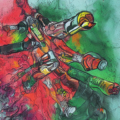I have refrained from discussing this topic for a considerable period of time. On one hand, addressing amphetamine dosage or dosages of any psychoactive substances for recreational purposes may appear to be an incongruous practice for a physician. On the other hand, understanding the dosages aligns with the concept of Harm Reduction. If a person is aware of the dosages, they will have more opportunities and reasons to comply with them. Consequently, the possible and unintended harm to their health will be reduced.
I comprehend that numerous exceptions and arguments may exist, but as I stated in the article about Legalization, knowledge is crucial for maintaining health.
Nevertheless, I will continue to augment the disclaimer. All the information that follows is based on average data and values, which are only appropriate for a physically and mentally fit adult. In other cases, the dosages and routes of administration for any modality can be hazardous, and I firmly advise against using stimulants for anyone who does not need them for medical conditions. Now, let us discuss the dosages in conjunction with the routes of administration.
Amphetamine routes of administration and timing

Amphetamines can be understood as different substances or their derivatives, but this whole article is devoted to alpha-methylphenethylamine, namely a review of its compound amphetamine sulfate dosage.
Amphetamines are commonly taken orally in the form of tablets or capsules. This is the most common route of administration in both therapeutic and recreational settings. The oral route is the easiest method of administering amphetamine, with powder taken by parachuting, mixing with a liquid, or put into capsules.
When ingested on an empty stomach, oral tablets containing amphetamine typically take 30 to 50 minutes to produce noticeable effects. Depending on the formulation, the duration of these effects can last anywhere from 4 to 6 hours for rapidly released tablets and 8 to 12 hours for extended release versions. It’s important to note that the duration of the effects can vary depending on factors such as an individual’s metabolism and dosage.
Pharmaceutical amphetamine preparations require no preparation for oral administration since this is their intended route. However, some users modify extended-release forms to receive the full dose at once by crushing the amphetamine-containing beads and ingesting them through parachuting or putting them back into the capsule.
Oral administration is generally the safest method of administering amphetamine. Oral administration also results in a less intense, longer-lasting effect.
Insufflation, snorting Amphetamine
Amphetamines can also be administered through the nose. This method is often used for recreational purposes. Anecdotal evidence and user reports show that snorting amphetamine increases its bioavailability, resulting in a more intense effect. But it seems to me that this may also be due to the setting, ritual, and placebo effect.
When insufflated, the effects of amphetamine appear within minutes and have a shorter duration of effect compared to the oral path. Amphetamine must be in the form of a fine powder to be insufflated. Street forms of amphetamine that are already in powdered form require little to no additional preparation before snorting. Pharmaceutical preparations of amphetamine can also be snorted but require varying amounts of preparation first. The extended-release versions of amphetamine are often more difficult to prepare for insufflation, so instant-release tablets are usually preferred. Although they are not created for this direction, they can cause problems in any case. One of the most widespread is significant nasal membrane damage.
Amphetamine injections, intravenous, IV
Injection of amphetamine is not used in the therapeutic setting and is generally uncommon due to the associated risks. Injected doses of amphetamine are usually administered intravenously or subcutaneously and are circulated rapidly through the bloodstream.
The practice of injecting amphetamine is mainly used recreationally due to the intense and immediate rush it gives users. Street forms of amphetamine can contain impurities that can have different negative effects, ranging from irritation to acute and life-threatening conditions caused by overdose. The intravenous route of administration significantly increases the risk of overdose. IV is a complex and dangerous method of use and implies difficulty in controlling amphetamine dosage.

Smoking Amphetamine
Individual cases of smoking amphetamine are described. However, people often complain of an unpleasant taste in the mouth, burning in the nasopharynx and lungs, cough, and rapid intense general effects, which are accompanied by headache, dizziness, and unpleasant experience. From this I can conclude that of course, you can smoke amphetamine, but only if you want to have a bad time.
Rectal Amphetamine, plugging
Amphetamine use by rectal administration is not as widespread as other methods and has not been subject to in-depth study or review. Plugging involves inserting amphetamine, typically in a water solution, into the rectum, where it is then absorbed.
While there is no substantial research on the matter, some anecdotal evidence and user reports suggest that amphetamine has good bioavailability when administered rectally. According to user reports, the effects of rectal administration come on more quickly than with oral administration, but not as quickly as with insufflation or injection. It also appears that plugging amphetamine produces effects that are more intense than those given by oral administration, but not approaching the intensity of effects produced by injection.
To administer amphetamine rectally, some users suggest that the drug can be inserted directly if dampened with water. However, this method is not recommended as it may cause significant irritation. A more commonly used method is to mix amphetamine powder or crushed pharmaceutical amphetamine with water to create a solution that is then administered rectally using a syringe.
It should be noted that the safety of administering amphetamine rectally has not been established, although it is considered to be safer than injection. The amount of irritation caused by rectal administration can vary depending on the methods used, the presence of inactive ingredients, and personal factors. Impurities, binders, dyes, and other inactive ingredients can also contribute significantly to discomfort and/or irritation. It is important to note that very little data exists examining the results of rectal amphetamine administration.
Lastly, if you have access to medical amphetamine in pill form and have a strong desire to experiment with it, I implore you not to do so. Manufacturers incorporate various stabilizing agents and other compounds in the tablets, and their behavior and consequences when snorted, injected, heated, or plugged are unknown. Please take good care of yourself.
Amphetamine dosage

The maximum recommended daily dose for amphetamines is generally 60 mg, although some individuals may require higher doses under medical supervision.
Usual Adult Dose for Narcolepsy
For narcolepsy, the amphetamine dosage usually starts 5-15 mg twice a day, which can be increased as needed.
To effectively administer medication, the first dose should be given immediately upon awakening, with subsequent doses given at intervals of 4 to 6 hours. It is recommended to avoid administering medication late in the evening to prevent the onset of insomnia.
The dosage of medication should be individualized based on patient response, with particular attention paid to any bothersome adverse reactions that may appear, such as insomnia or anorexia. If these adverse reactions are present, it may be necessary to reduce the dosage of the medication.
Usual Adult Dose for Obesity
To utilize amphetamines for weight loss, immediate-release tablets are typically taken orally at a dose of 5 to 10 mg. The maximum daily amphetamine dosage should not exceed 30 mg.
It’s important to note that amphetamines are generally considered to have limited usefulness for weight loss, and the potential risks associated with their use should be carefully weighed against their limited effectiveness. It is recommended to administer the lowest effective dosage and adjust the amphetamine dosage based on individual needs. It is also advised to avoid taking amphetamines late in the evening due to the potential for insomnia.
Amphetamines may be utilized as a short-term adjunct in a regimen of weight reduction based on caloric restriction, particularly when other treatments have proven ineffective, such as repeated diets, group programs, or other drugs. However, the use of amphetamines for weight loss should be approached with caution and under the guidance of a healthcare professional.
Usual Adult Dose for Attention Deficit Disorder
The maintenance dose for immediate-release medication typically ranges from 5 to 40 mg taken orally per day in divided doses. Amphetamine dosage may be increased in increments of 5 mg at weekly intervals until an optimal response is achieved. These doses may be given at intervals of 4 to 6 hours throughout the day, with late-day doses being avoided.
For extended-release medication, the recommended dosages vary based on the form of the medication. Adezenys XR oral disintegrating tablets, the recommended dosage is 12.5 mg taken orally once a day. Dyanavel XR oral suspension, the initial dose is typically 2.5 or 5 mg taken orally once a day in the morning.
A lethal dose of Amphetamine
The median lethal dose for amphetamine sulfate is 24.2 mg/kg orally for mice. There will be no details in this section.
Usual Adult Dose for Recreation and Personal purposes
| Oral | Insufflated | Intravenous | |
| ⚪ Light | 5 – 15 mg | 5 – 10 mg | 5 – 7 mg |
| 🟡 Medium | 15 – 30 mg | 10 – 25 mg | 7 – 15 mg |
| 🟠 Potent | 30 – 60 mg | 25 – 40 mg | 15 – 30 mg |
| 🔴 Severe | 60 mg and more | 40 mg and more | 30 mg and more |
Rows – dosages in connection with the expected strength of the effects. Columns – routes of administration
I will not discuss the recreational or purportedly beneficial impacts of amphetamine. Instead, I will concentrate on its adverse effects. The critical point to consider is that the intensity of negative effects rises proportionally with the amphetamine dosage. This is a crucial factor to bear in mind, as individuals often unwittingly subject themselves to harmful consequences in their pursuit of extending or enhancing the desired effects.
Amphetamine side effects
Amphetamine can cause a range of side effects, some of which can be serious. The exact side effects of amphetamines may vary depending on the individual’s response to the medication, the dose, and the duration of use. Some of the most common side effects include:
Mental effects: Agitation, anxiety, nervousness, abnormal thought patterns, confusion, panic attacks, paranoia, and psychosis, especially at high doses or with long-term use. Increased aggressiveness and risk-taking behavior may also be observed
Cardiovascular effects: Increase blood pressure, heart rate, irregular heartbeat, and the risk of heart attack and stroke. Skin color change from pale to blue to red on the fingers or toes sometimes manifests. Long-term use of amphetamines can also cause damage to the heart and blood vessels.
Gastrointestinal effects: Stomach pain, nausea, vomiting, diarrhea, or constipation. Abdominal pain also. Amphetamine can decrease appetite and cause weight loss, which can be beneficial for some medical conditions but can also be a problem for people who need to gain weight. It is dangerous for a healthy person, without hormonal or other pathologies, to use amphetamine for weight loss.
System effects: Increased body temperature/sweating. Dry mouth. Swelling of the face, throat, tongue, lips, or eyes. Weakness or numbness of an arm or leg. Insomnia and other sleep problems.
Neurological effects: Blurred vision, Impaired speech, Motor or verbal tics, Headache, Dizziness, Twitching, Difficulty breathing or swallowing, and Convulsions.
Skin problems: Skin rash, hives, and itching, which can be a sign of an allergic reaction.
Other side effects: Problems with potency and sexual side effects. They may be temporary, or they may become chronic. Grinding or clenching teeth. Painful menstruation. Pain or burning when urinating.
Wow, it turned out too much even. Maybe amphetamine isn’t so good? You may gain a better understanding of why amphetamine causes specific side effects by reading my article How Amphetamine works.

Conclusion
I conveyed all the information I knew about the dosages of amphetamine, even though I found the article to be rather difficult and often encountered resistance while writing it. My sole objective is to equip people with knowledge about the functioning and effects of psychoactive substances. I cannot anticipate how individuals will utilize this information, but I hope it proves to be beneficial.
Therefore, I strongly advise taking amphetamines only as prescribed by a healthcare provider and avoiding any misuse or abuse of the drug. They can be helpful for treating medical conditions such as attention deficit hyperactivity disorder (ADHD) and narcolepsy.
✔️
This marks the finish of today’s session. It is my hope that this piece was enlightening.
If you desire to advance the growth of this blog, I suggest the following actions:
- Follow my Twitter.
- Circulate a link to this article among your associates.
- Give recognition to this blog on relevant platforms or discussion groups.
Should you identify any necessary additions or corrections in this article, feel free to initiate a dialogue with me via Contact Form. I am always open to communication.
I express my gratitude for your valuable time and consideration 💊




